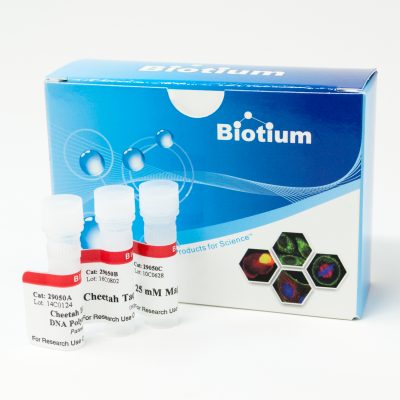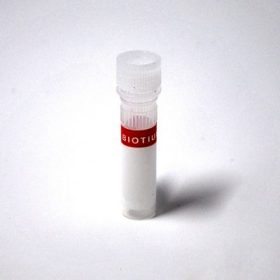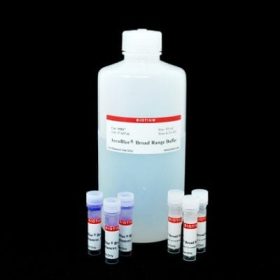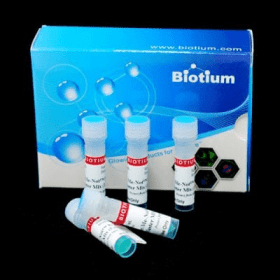Cheetah™ Taq is a chemically modified hot-start Taq DNA polymerase useful for preventing or reducing nonspecific DNA amplification in PCR. Modified using a novel modifying reagent, Cheetah™ Taq represents a major improvement upon AmpliTaq® Gold by having a faster activation time and better shelf-life.
Features
- Hot-start Taq polymerase
- Modified using unique hot-start chemistry
- Absolutely no activity at room temperature
- Fast activation: takes less than 2 minutes of heating to activate
- Very stable during storage
Components
- Cheetah™ Taq, 5 U/uL, 100 uL
(in buffer containing Tris-HCl pH 9.0, DTT, EDTA, KCl and glycerol) - 10X Cheetah™ Taq Reaction Buffer (without Mg2+), 1.5 mL
- 25 mM MgCl2, 1.5 mL
Under standard hot-start conditions (i.e., 94°C in pH 8-9 Tris), Cheetah™ Taq regains both the 3′-5′ polymerase and 5′-exonuclease activities within two minutes. Cheetah™ Taq is also superior to antibody-based hot-start DNA polymerases due to its complete suppression of enzyme activity at room temperature and full recovery of enzyme activity following activation.
AmpliTaq is a registered trademark of Thermo Fisher Scientific.
PRODUCT ATTRIBUTES
| Concentration | 5U/uL |
|---|---|
| Storage Conditions | Store at -10 to -35 °C |
protocol
SDS
supporting documents
REFERENCES
1. Oncotarget (2011) 2:358-362 doi:10.18632/oncotarget.287
2. Eur Food Res Technol (2011) 232(6):1057-1060 doi: 10.1007/s00217-011-1482-0
3. Food Anal Methods (2011) 4, 116–120 doi:10.1007/s12161-010-9141-9
4. Clin Chem (2012) Apr;58(4):725-31 doi:10.1373/clinchem.2011.180356
5. PLoS One (2013) 8(6): e67082 doi: 10.1371/journal.pone.0067082
6. BMC Res Notes (2014) Oct 15;7:727 doi: 10.1186/1756-0500-7-727
7. ScientificWorldJournal (2014) 2014:893981 doi: 10.1155/2014/893981
8. Prog Neuropsychopharmacol Biol Psychiatry (2015) Apr 3;58:71-80 doi: 10.1016/j.pnpbp.2014.11.008
9. J Low Genit Tract Dis (2016) Oct;20(4):332-7 doi: 10.1097/LGT.0000000000000251
10. Pol J Vet Sci (2017) Dec;20(4):795-801 doi: 10.1515/pjvs-2017-0100
11. Food Control (2018) 83; 118-122 doi:10.1016/j.foodcont.2016.12.026







